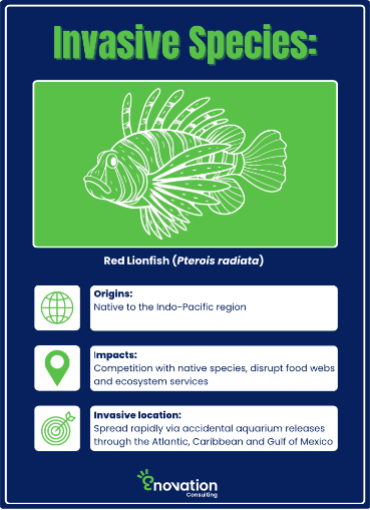Invasive & Endangered Species: How Climate Change Distorts Marine Ecosystems
Photo by Wolfgang Hasselmann on Unsplash
Climate change is reshaping marine biodiversity at an unprecedented pace. Marine heatwaves, which have surged 300% over the last 80 years, drive organisms to cooler waters, creating opportunities for invasive species to spread while increasing the vulnerability of already endangered species.
Invasive species are non-native organisms that spread beyond their natural habitats, disrupting established ecosystems. They thrive in changing environments because they possess broad ecological tolerances and high adaptability traits. Once established, they outcompete native species for food and space, introduce disease, and alter entire food webs.
The lionfish invasion of the Atlantic and Caribbean from its native Indo-Pacific region is a striking example: by preying on herbivorous fish that graze on algae, lionfish indirectly fuel algal overgrowth on coral reefs, blocking light, consuming oxygen, and reducing ecosystem productivity. Such disruptions undermine both biodiversity and the vital services that healthy oceans provide to coastal communities, including sustainable fisheries, tourism revenue, and coastal protection.
In stark contrast to those thriving in marine conditions, an estimated 500 marine species are slipping closer to extinction. These include the critically endangered Hawksbill Turtle, which faces multiple threats from habitat loss due to coastal development, bycatch from fisheries, pollution, illegal trade, and climate change impacting nesting success. These pressures reduce resilience to environmental change and stressors, threatening not just individual species but also the ecosystems they support. When biodiversity declines, communities that rely on the ocean for food security and livelihoods also suffer.
Safeguarding biodiversity requires urgent, collective action. Reducing greenhouse gas emissions is critical to slowing the environmental changes that drive both invasions and extinctions. Ambitious regulatory protection of coastal and marine habitats, such as the recently ratified UN High Seas Treaty, alongside the restoration of degraded ecosystems, will also improve marine resilience. The UN High Seas Treaty is a much-needed win for the planet’s oceans: following nearly two decades of negotiations, the treaty will establish a network of marine protected areas in the High Seas, a vast expanse of open ocean that had not previously been subject to any legally binding international conservation agreements.
Protecting marine ecosystems from invasive species while defending endangered ones is not only about saving wildlife; it is about securing the health, food systems, and economies that depend on them. COP30 presents a much-needed opportunity to boost momentum behind marine biodiversity protection measures following the ratification of the UN High Seas Treaty.



